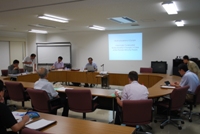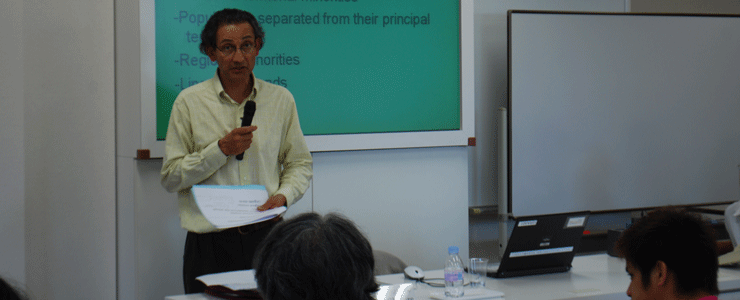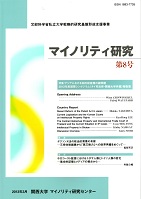Kansai University, Center for Minority Studies, Summer Special Lecture of 2010
“The European Multiculturalism at the Crossroad”
Lecturer: Professor Kleber Ghimire (University of Grenoble the Third).
First lecture:
Theme: Multiculturalism in the Europe – the uniformity of systems and discussion on scope of its implication.
Chairperson: YASUTAKE Masataka (Professor of Kansai University, Faculty of Policy Studies).
Second Lecture: (Organized by Kansai University, Institute of Legal Studies)
Theme: History-constructed Multiculturalism–The Case Study of Rome (Romany) Minority.
Chairperson: TSUNODA Takeshi (Professor of faculty of law, Kansai University)
Third Lecture:
Theme: Newly-invented Multiculturalism-the Case Study of Muslim Minority.
Chairperson: OTSURU (Kitagawa) Chieko (Professor of faculty of law, Kansai University)
For the purpose of introducing the European trend in Multiculturalism, to which Japan has not been familiar yet in comparison, The Center for Minorities Studies had invited Professor Ghimire for the Summer Special Lecture for undergraduate/ graduate Student, researcher, and local people. This Special Lecture had been conducted by three separated lectures, each one is independent from the others, but has been carefully prepared so that attending these three lectures continually will result in the in-depth systematic knowledge. The first lecture on “Multiculturalism in the Europe – the uniformity of systems and discussion on scope of its implication” explain about; for example, the fundamental idea of minority protection in the European Region, introducing the system and documents relating to the protection and relating problems, etc., of the European multiculturalism outline.
Next, the second lecture on “Multiculturalism Created by History–The Case Study of Rome (Romany) Minority” as well as the third lecture on “Newly-invented Multiculturalism-the Case Study of Muslim Minority” is case study. The second lecture brings the matter of Romany Minority to consideration regarding the traditional minority problem in the European region. And the third lecture is about the new minority which is the result of global movement of people nowadays, brings the situation of the European Muslim to be the subject of consideration. The contents of each lecture can be explained as the following;
* * *
(1) Multicultural in the European Region-disputes on the systems and the standards.
【Main points】
In European region, most disputes on the political and standard are relating to the “Majority’s problem”. The politic with the purpose of “the greatest happiness of the greatest numbers” (Bentham), generally aims at creating the welfare for the majority. However, the European region has rooted from so many languages, religions, and races that the relationship between the minority problem and the formation of EU should be described as a very close one. In the European Region, there is philosophy of human respect, traditional ideas about political liberalism, which accept the plurality of culture and these matters have become the foundation of multiculturalism. Furthermore, the social conflict or dispute in the European region solved from the point of view of the whole European community that consequently, the European region has historical experiences of treaty entering or standard creating. These matters are also being used in normative approach for minority problem.
Multiculturalism of the European region (existence of the minority culture) can be categorized in 2 patterns; one is the “multiculturalism created by history”, which can be diverged to area-related minority and the non-area related minority. Area-related minority means; for example, Breton people or Basque people means minority which inhabit at the area of the country. A well-known example of non-area based minority is the nomadic living of the Romany people. The other Category is the Newly-invented minority; including the migrants within the European region, migrants from the colony, guest workers (foreign workers recruitment due to shortage of labor during the period of 1960 to 1970), immigration results from globalization nowadays.
The general definition of minority is the people who are, ① being different from the majority,② being the smaller number, ③ not being in the controlling position, ④ possessing the group identity. The definition given by EU further requires that they must have an area basement. Therefore, it is necessary to point out here, the fact that a group of people without area basement; for example, the Romany is not recognized as the minority in this meaning.
A cross-border organization such as the EU creates the standard for minority protection through the Organization for Security and Cooperating in Europe (OSCE) or the Council of Europe (CoE), the European Community (EC). Nevertheless, most of these standards have some problems; for instance, ① their significance is merely a declaration of principle, ② having no legal binding power, ③ their significance is about human rights (individual rights) standard, does not reflect on the collective rights of minority, ④ deficient in enforcement monitor, etc.
Besides, there is a problem within the minority; that is, the procedure for confirming and claiming their own needs is not clear. In addition, the Nation-state or the society, the rightists’ power, opposing the minority claiming their rights makes the protection even more difficult.
Here the conclusion may be; ①the minority problem is usually not being placed as a priority by the Nation-State, ② the regulation on protection of minority rights are only the soft law which lacks of legal binding power, ③ the collective rights of minority is not sufficiently recognized, ④ there is a gap between the standard and the enforcement in reality; These problems need be solved.
<<Question>>
The attendees had asked, and together, Professor Ghimire had discussed the following questions;
① What is the difference between the human rights as minority rights and the collective rights of minority, and is such a concept distinction appropriate? ② What is the distinctiveness or inherent nature of the European minority problem compares to the minority problem which occurs in the other area of the world? ③ Is the protection under the EU more favorable than protection by a Nation-State?
* * *
(2) The Roma (Romany) Minority – an example of the multiculturalism created by history.
【Main points】 The root of the Romany are, the Kalderash from the Central Europe, and the Kale from the Scandinavia, and the Sinti from Germany, and the Manouche from France gathered together. The Romany population in the entire European area ranks from 12 million to 15 million, and 1million of this number resides in the EU. The reason why we focus on the Romany is; for instance, ①They are the largest number of minority without area foundation in the European region. ②The problem in concern is the historical minority problem. ③They had been under discrimination and oppression for a long period of time. ④ The problem is the affect form various legal systems.
The origin of the Romany is traced as the people who had been sold as slaves in the 11th Century of the Ghazni Dynasty (at present the area around Afghanistan or Pakistan) who had moved to the European region. They had reached Greece and Egypt in the 14 th Century; and in the 15 th Century, they had resided in Hungary, Germany, France, Spain. Nowadays, they are scattering in many areas of the European region; especially in Spain, France and in various countries in the central Europe.
Their history of oppression is said to have been started from the 14 th Century they had been under slavery in Rumania (which lasted until 1856); and the Roma exile in Switzerland in the 15 th Century. They had become the target of discrimination; for example, exile, restricted settlement, forced to migrate to the colonies or excommunicated. In the 19 th century, the interest in romanticism had beautified their image and spreaded it out. However, the discrimination persisted, in Germany under the reign of the Nazi they had been sent to the concentration camp together with the Jewish, where a considerable number of them had been killed. In the post-war period, under the assimilation policy of the Communism, despite the fact that they had been recognized equally as citizen, their cultural identity had been restrained.
At present the Romany still is in distressing conditions; for example, the poverty, poor quality of residence, low standard of education, high rate of unemployment, etc. Their income resources are street vendor or door-to-door sale, seasonal agricultural worker, garbage collecting, cleaning, making traditional handicraft, dancing, or providing other kinds of recreation. In order to improve the present condition, the Romany require ① respect for their nomadic living, ② protection for their language, ③ access to medical services and health insurance, ④ provision of housing, drinking water and the infrastructures, ⑤ Physical and legal protection from discrimination or attack.
The EU has been handling the Romany problem via the Organization for Security and Cooperating in Europe (OSCE) or the Council of Europe (CoE). The main EU policies are derived from these three policies; that is, ① Have the Romany belonged to a designated area by providing them housing and citizenship, ② Respect the fundamental human rights of the Romany and ③ Protect their language and culture of nomadic living.
The main problems concerning the conditions of the Romany may be observed as the following;① Many countries still hold the policy of restricted settlement or assimilation policy, ② The society still have dislike or fear of the “Gypsy”, ③ The expansion of power of the rightists which treats the Romany as “criminal”, ④ The framework of individual human rights protection (collective rights protection is not recognized), ⑤ There is a conflict between groups of Romany and failure in political movements.
<<Question>>
An attendee had asked a question about how the provision of citizenship to the Romany is proceeding, and Professor Ghimire had explained about both positive and negative thoughts about the citizenship provision. Furthermore, there was a question from the attendee that whether it is unavoidable to accept or abandon the lifestyle of the Romany, including their nomadic living, in order to improve the quality of life of the Romany worldwide? Then the class, including Professor Ghimire, had been discussed actively on the matter.
Editor, Professor Nishi Taira (Assistant Professor of Faculty of Law, Kansai University)
* * *

Researcher/ local persons attending the lecture.
(3) The Muslim Minority: the new minority resulted from multiculturalism
<Abstract>
This problem has also been closely observed recently besides the Pan-European Romany Minority. Here, the Muslim problem has been discussed as a specific example of the problem about the rights of people migrated into Europe.
The concept of Multiculturalism means accepting cultural differences; that is, minority group should not be excluded from and treated as subordinate to the grout of majority, their right should be equally protected. Nowadays, as substantiation of human rights is focused universally, the concept of multicultural is, not only in the European region where there is the Declaration of Human Rights, the European Court of Human Rights, most of other regions find it is hard to deny this concept officially. However, in reality, the Muslim cultural right and their right to religion is not always under protection. Professor Ghimire had tried to clarify about what is the gap between ideal and reality, and what is the problem that we should figure out.
In the European region, the Muslim are viewed differently, nonetheless, they are not unknown entirely since the European culture originated from the Mediterranean Sea and was influenced by Islamic religion. There are some parts of the region; for instance, Iberia or the central and southern part, which had been under the control of Islamic religion. However, the problem of the Muslim in the European region is not about these Islamic who have been living in the European region long before, indeed, this is about those who had been migrated from colony, or migrated as guest worker, then followed by their family. We will discuss about those who newly migrated into the European region.
There are some, among the new immigrants Muslim, especially those who are the second generation downward, have received European citizenship. And unlike their ancestry who Islamic religion is the matter of an individual belief, they claim equality in religion rights in the society. According to the fact that in many European countries, there are a considerable number of the Muslim citizens that cannot be ignored, this change in the Muslims affects identity of the Christian group, and caused indefinite reactions; including the rightist movements. France used to take no special preference in any religions in the past; the latent superiority of the Catholic indicates that there is no protection for religious neutrality. In addition, although this has been only on the cultural dimension, there are, at any rate, the policy set against the Muslim. In addition; this has been developing to be similar to the German Corporatism.
Professor Ghimire has been, by discussion, and with consideration of the fact that most Muslims in the European region are peaceful, explaining the possibility to substantiate the multiculturalism. And the phrase “Muslim of European” or the ‘European Muslim people” is, from the point of view of the Muslim, possibly indicating their need of acceptance on cultural or religion dimensions.
<Question>
There was a question from an attendee that whether protection of the cultural right or right to religion of the Muslim would affects culture of the accepting society. The doubt about collective, not individual, protection of the Muslim right was expressed. And the problem of Turkey, which economically is necessary, but has not been accepted as one of the European due to the religious problem was raised and discussed actively with professor Ghimire.
* * *
It should not be only majority of a culture requiring standardize, genuine, criteria which take control of the public space. The significance of multiculturalism means different cultures should share the public space. However, the multiculturalism, not only in Europe but also in the USA and Australia, is facing the problem that persons in the majority side, from their personal feeling level, resist, that they are still struggling to find the solution. On the other hand, in Japan, coexistence of many cultures is claimed, whereas, the state of “coexistence” discussed is limited only from the point of view of the major culture. There is the fact that, the idea that Japanese culture has to be protected; therefore, protection of minority’s right is not accepting them as a member of the society; rather close the entry to Japanese society then except them merely as one of the temporary and non-Japanese member. This Japanese style of “coexistence” is doubted for how long it will possibly last. As Japanese society nowadays is developing towards multicultural, there is a question on how the minority problem, which contrasts negatively, would be reformed to be a constructive coexistence. This continuous seminar had also questioned us how we should put an afford to protection of our own human rights.
“The European Multiculturalism at the Crossroad”
Lecturer: Professor Kleber Ghimire (University of Grenoble the Third).



